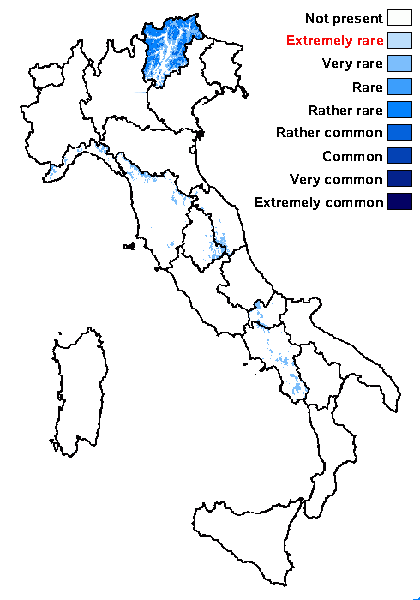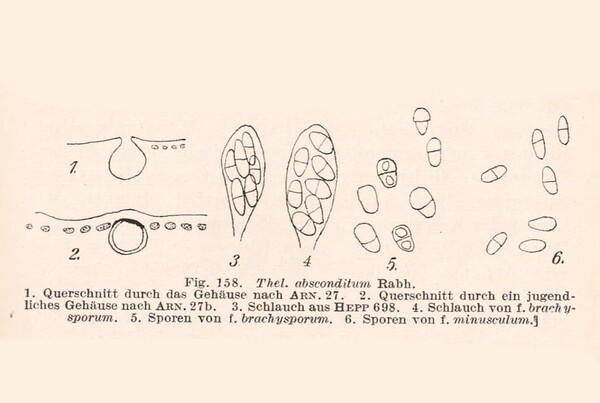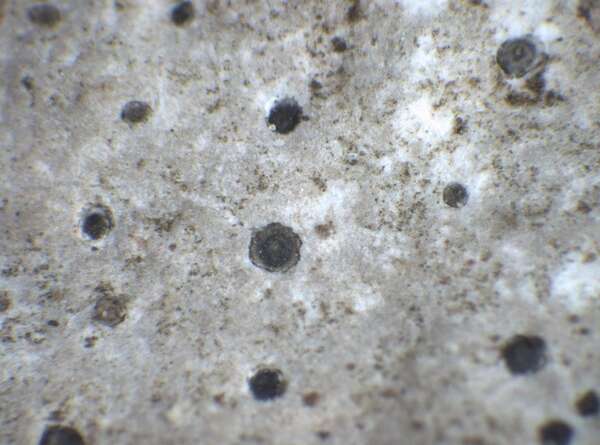Thelidium absconditum (Hepp) Rabenh.
Flecht. Eur.: nr. 797, 1867. Basionym: Sagedia nigrella var. abscondita Hepp - Flecht. Eur.: nr. 698, 1860.
Synonyms:
Distribution: N - TAA (Nascimbene & al. 2022), Lig. C - Tosc (TO 3390), Marc (Nimis & Tretiach 1999), Umb (Genovesi & al. 2002, Ravera & al. 2006), Mol (Garofalo & al. 1999, Caporale & al. 2008). S - Camp (Garofalo & al. 1999, Nimis & Tretiach 2004).
Description: Thallus crustose, endosubstratic, continuous, grey- or yellowish-white, sometimes delimited from conspecific thalli by black lines and forming mosaics. Perithecia black, 0.1-0.25 mm across, completely immersed in pits in the rock, visible only as c. 0.1 mm wide, black dots. Involucrellum absent; exciple brown-black throughout, thicker around the ostiole; hamathecium of periphyses and periphysoids, interascal filaments absent; hymenial gel I + red (I+ blue at very low concentrations of I), K/I + blue. Asci (6-)8-spored, ellipsoid to clavate, I-, fissitunicate, the wall thickened above, with an ocular chamber, dehiscent by extrusion of a delicate rostrum. Ascospores 1-septate, hyaline, ellipsoid, often pointed at one end, (15-)18-32(-36) x 7-11(-15) μm. Photobiont chlorococcoid. Spot tests: K-, C-, KC-, P-, UV-. Chemistry: without lichen substances.Note: on limestone, dolomite, calciferous schists in upland areas; certainly more widespread also in the Alps. The relationship with Th. decipiens remains to be clarified. An earlier record from Venezia Giulia (see Nimis 1993: 685) is not accepted here, as it is far from the present border.
Growth form: Crustose endolithic
Substrata: rocks
Photobiont: green algae other than Trentepohlia
Reproductive strategy: mainly sexual
Poorly known taxon in need of further study
Commonnes-rarity: (info)
Alpine belt: rather rare
Subalpine belt: rather common
Oromediterranean belt: extremely rare
Montane belt: very rare
Submediterranean belt: absent
Padanian area: absent
Humid submediterranean belt: absent
Humid mediterranean belt: absent
Dry mediterranean belt: absent

Predictive model
Herbarium samples
Growth form: Crustose endolithic
Substrata: rocks
Photobiont: green algae other than Trentepohlia
Reproductive strategy: mainly sexual
Poorly known taxon in need of further study
Commonnes-rarity: (info)
Alpine belt: rather rare
Subalpine belt: rather common
Oromediterranean belt: extremely rare
Montane belt: very rare
Submediterranean belt: absent
Padanian area: absent
Humid submediterranean belt: absent
Humid mediterranean belt: absent
Dry mediterranean belt: absent

Predictive model
| Herbarium samples |
 INDEX FUNGORUM
INDEX FUNGORUM
 GBIF
GBIF
 DOLICHENS
DOLICHENS





